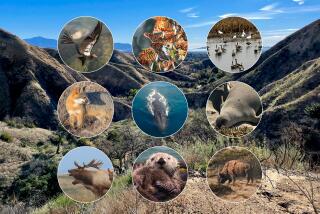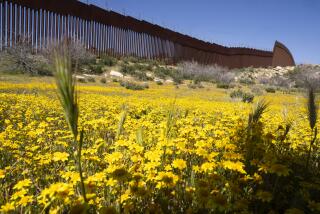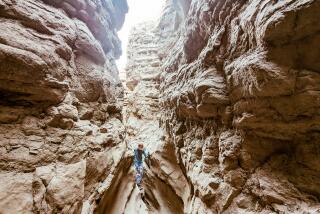Cruise: Costa Rica : Jungle Calls : Ants, birds, monkeys, mud --a rain forest eco-voyage
ABOARD THE TEMPTRESS VOYAGER â âMadam, please, youâre stepping on them,â said naturalist Miguel Ortega with a tinge of irritation. He had just explained the complex social structure of rain forest leaf-cutter ants, when one hiker, in her enthusiasm to see the bobbing, green parade, put a boot down on the lecture subjects.
Ortega was a guide from the M.V. Temptress Voyager, an expeditionary cruise ship that plies Costa Ricaâs lush, national-park-lined Pacific Coast. Our small group of ant watchers was hiking through the steam-bath rain forest at Corcovado National Park on the Osa Peninsula--much of which is accessible only by boat.
Begun in 1991 as the first âeco-tourâ line in Latin America, Temptress Voyages has two expeditionary ships, the 163-foot Voyager and the 185-foot, 99-passenger Explorer. Besides being comfortable and convenient, these small cruise ships are one of the least invasive ways to visit vulnerable natural habitats. No hotels need to be built; all trash and other waste leave with the ship; visitation, impact and access are temporary and limited.
With its tiers of cabin windows and open decks, the shallow-draft Voyager looks like a streamlined Mississippi riverboat. In place of a paddle wheel is a low deck, just above water level, designed for launching Zodiacs--motorized inflatable rubber boats that ferry passengers to and from shore and up shallow rivers. The Zodiac deck is also a launching pad for swimmers or kayakers exploring nearby coves.
Besides transport to some of Costa Ricaâs most exotic sites, the Voyager served as a floating water-sports center, offering--in addition to swimming and kayaking--water skiing, snorkeling, scuba diving, sport fishing, and, of course, sunbathing. The Voyagerâs air-conditioned cabins, dining room and breezy deck-top cocktail lounge--ideal for viewing tropical sunsets--provided a comfortable refuge after long, hot days in the jungle.
The Voyager is not for the glitzy. Night life consisted of conversation on the top deck, with tropical drinks and maybe a little music. Our only floor show was traditional dances performed by children from the village at Drake Bay (named for Sir Francis Drake, who took refuge there).
Eco-passengers have quite a different agenda from luxury cruisers. Howard and Shelly, a 30ish couple from Albuquerque, N.M., were looking for active adventure and an escape from thousand-passenger ships. Myra and George, retired professionals from New England, loved nature and bird-watching. (Myra lugged her heavy tripod through the jungles to photograph birds, monkeys and flowers.) Californians Roger and Darleen were the aerobic type, always kayaking, hiking or swimming.
Cruising slowly along Costa Ricaâs Pacific coast, the Voyager offered its 63 passengers the solitude of the sea and panoramic views of a nearly pristine environment.
*
The three-night, four-day cruise began in the small Pacific port of Puntarenas, after a scenic ride from San Jose, the Costa Rican capital, and ended at Manuel Antonio National Park. The Voyager made five stops, three at national parks or refuges. Each evening, we usually anchored within kayaking or swimming distance of a beach.
Christopher Columbus was the first European to set foot in Costa Rica. Taking shelter from stormy seas, he anchored on the countryâs Caribbean coast in 1502 during his last voyage to the Americas. He found the land so full of food, wildlife and hospitable natives that after his visit, the area became known to Europeans as Costa Rica or âRich Coast.â We, too, feasted on Costa Ricaâs shores. After our rain-forest forays, the Voyager staff set out spreads of salty olives, cheese, fruit, soft drinks and other snacks to replace what the jungle had wrung out of us. Our usual meals in the shipâs dining room, were supplemented with beach barbecues of fresh fish and chicken.
Each day aboard began with a hearty breakfast of local coffee, fresh tropical fruits, homemade breads and pastries, eggs and gallo pinto (rice and beans).We sailed mostly at night, arriving in the early hours off forested shores, so after breakfast we were ready for the dayâs activities. Our choices--depending on the anchorage--were nature walks, deep-sea fishing, snorkeling and scuba diving, kayaking or just lounging on the ship or local beach.
Most passengers chose the nature walks. Nearly one-quarter of Costa Rica is protected with national parks or reserves, so thereâs a lot of nature to see. Because itâs a part of the land bridge between North and South America, the country has a spectacular array of birds and wildlife from both continents.
Miguel Ortega was the most experienced of three on-board naturalists. He had spent 12 years as a game warden in parks and reserves all over Costa Rica, and the serious nature-lovers on board practically fought over spots in his nature walks. Walks were classified either as ânatural historyâ (harder and longer) or ârecreationâ (shorter and easier). All Ortegaâs walks were natural history.
Our first stop was Curu National Wildlife Refuge, considered a dry tropical forest. Moisture-laden winds mostly bypass Curu, and our April visit came at one of the driest times of the year. It was a bit shocking to see bare trees in the tropics, but nice not to have to fight the usual hordes of insects.
Ridley, leatherback and hawksbill sea turtles nest on Curuâs beaches, and the refuge attracts more than 100 bird species. After climbing down a ladder to the Zodiacs in the gently rocking sea, we sped across the rollers toward the palm-lined beach and the mysterious jungle beyond.
As we walked across wood catwalks, which keep visitorsâ feet dry at high tide, Ortega explained the unique ecology of the mangrove swamps lining the shore. When the tide is in, fish and other marine creatures find protection among the raised, tangled tree roots, which also act as nurseries for their young. Mangrove trees siphon salt from the marshes, making the sandy beachfront soil more fertile, and luring the jungle closer to the seaâs edge.
On entering the jungle, we heard a rustling in the brush. Ortega shushed us and we stood silently, hoping to spot our first wild jungle animal. It turned out to be a squirrel. The next exotic creature we saw was a raccoon, and then a sparrow. But not everything looked like something from my backyard. A wild roaring in the treetops introduced us to a troop of howler monkeys. They scurried through the branches like acrobats, and we performed our own back- and neck-wrenching contortions to take photos.
That night we headed for remote Corcovado National Park, on the 30-mile-long Osa Peninsula, which hooks out into the Pacific not far from the Panamanian border. Parts of Corcovado receive more than 16 feet of rain a year and, not surprisingly, itâs considered a âwetâ tropical forest. One of the last virgin rain forests in Central America, it harbors more than 300 species of birds, 139 species of mammals and 116 species of amphibians and reptiles, including a number of endangered species, such as the ocelot, puma, Bairdâs tapir and jaguar.
In fact, fully 20% of Corcovadoâs visitors are scientists doing research, and the first thing to greet us on shore was a rustic research station dwarfed by towering trees. Corcovado is the seething, stewing, dripping, luxuriant jungle we all imagine. Itâs filled with twisting tendrils, cavernous trees, poisonous frogs, strangler figs and muddy trails. As Ortega led us through this wet wonderland, hikers wearing boots with inadequate tread spent a lot of time skiing the hills--frequently backward--and getting face to face with the jungle floor.
Fantastic flowers, filigreed with delicate petals attracted insects with their sticky pollen. Beautiful electric-blue morpho butterflies, flitted through the mottled under-canopy, looking like falling pieces of sky. There are millions of creatures in any rain forest, but most are hidden in the canopy or are nocturnal. However, with the help of Ortegaâs trained eye, we did see howler and white-faced monkeys and the leaf-cutting ants.
âLight is the most important element of the rain forest,â Ortega said. âThe leaf-cutters play a vital role in the diversity of the forest because they clear away some of the canopy foliage to let in more light for different species of plants--which are all competing.â Some plantsâ leaves have red undersides to collect infrared light rays near the dark rain forest floor. We never saw the tiny poison-spitting, red and green dart frogs--perhaps just as well--but we did see strangler figs, so-called because they climb other trees, vine-like, seeking the light, and eventually strangle their hosts to death.
Towering trees arching overhead give the rain forest a cathedral atmosphere, and I felt a pilgrimâs reverence walking along quietly amid the forest spirits. Silence is a prerequisite for seeing or hearing wildlife--especially birds--so conversation was minimal (mostly collective âoohsâ or âaahsâ). Occasionally, a birdâs call punctuated the silence and Ortega would help us find it amid a million leaves. Few things compare to spotting your first toucan or scarlet macaw in the wild.
The heat and moisture were oppressive. To avoid bug bites, I had worn a long-sleeved shirt, hat and army jungle fatigues and had covered every inch of exposed skin with industrial-strength bug repellent. Lugging a heavy camera bag and tripod didnât help. Compared to most of the others, scantily clad in shorts and T-shirts, I looked like a wilted Indiana Jones. But as they slipped and slid, accumulating mud and scratches, I was glad for my hiking boots and protective clothing.
After our jungle walk we rode the Zodiacs up the AgujitasRiver, which empties into Drake Bay. The crew had a surprise for us there: jumping into the river and swimming the rapids. âWhat about leeches,â I asked, thinking about a scene from âThe African Queen.â âNo leeches,â said Ortega, so I slipped into the cool, fresh water and slid along the gentle rapids.
Later that afternoon, I sat swaddled in a towel, sipping a pina colada and absorbing it all in the exquisite comfort of a chaise lounge on the shipâs deck. A traditional dance performance by the kids from Drake Bay was about to begin right in front of me. Exotic nature, recreation and culture all in one remarkable day.
About midway between Corcovado and Curu is Manuel Antonio, one of Costa Ricaâs most popular parks. Itâs a veritable zoo of exotic creatures. Monkeys practically fall out of trees onto bystanders. Everywhere you look thereâs a rare bird; hummingbirds seem as plentiful as flies.
Like Corcovado, Manuel Antonio is a wet tropical forest, but not quite as wet. Because it isnât as isolated as the other parks the Voyager visits, we mingled with other tourists. But it didnât matter; there were enough wonders for everyone. Within minutes of stepping onto the parkâs beautiful white sand beach, we spotted a rare stump bird--or potoo--which resembles a large whippoorwill when itâs not doing its tree-branch-look-alike act. Capuchin monkeys cavorted in tree branches practically at armâs length. Capuchins are named after a Franciscan order of monks because their white faces and dark crown of hair makes them look as if they are wearing a monkâs hood.
We watched transfixed as a big three-toed sloth and its baby took shelter from a downpour under the fronds of a tall, umbrella-like palm tree. Several species of beetles, mites and moths nest in the slothâs pelt, along with two different species of blue-green algae. The algae gives the animalâs gray coat a greenish hue that helps camouflage the extremely slow-moving creature in the trees, its main defense. And indeed it was hard to spot this beast, which that day looked like a wet, moldy mop.
It was at Manuel Antonio that we disembarked. At this point we had earned our sea legs and found ourselves reeling whenever we were back on land. I was sad to leave newfound friends, cozy cabins and daily adventures launched from my floating hotel. But the small town of Puerto Quepos near the national park afforded a gateway to volcanos and other inland adventures--places that even the Temptress Voyager couldnât reach.
* ECO-CRUISES: A listing of expeditionary cruises. L16
(BEGIN TEXT OF INFOBOX / INFOGRAPHIC)
GUIDEBOOK: Nature of Cruising in Costa Rica
Cruise itineraries: Temptress cruises begin in Puntarenas or Golfito, Costa Rica, and include land transfers from San Jose to Puntarenas and air transfers to Golfito. Temptress Voyages offers special family cruises from June through September. The program includes nature talks, sand-castle contests and essay contests, as well as separate dining with a kidsâ menu.
What it costs: Three- to six-night cruises cost $795-$1,495 per person, double occupancy (June-Sept.) and $895-$1,695 (Nov.-May). Prices include all meals, transfers, bar stock liquor, laundry service, park fees and all water sports except sport fishing. Air fare not included.
For more information: Temptress Voyages, 1600 N.W. Le Jeune Road, Suite 301, Miami, FL 33126; telephone (800) 336-8423.
For more information: The Costa Rica Tourist Board, P.O. Box 777-1000, San Jose, Costa Rica; tel. (800) 343-6332.
--R.G.
More to Read
Sign up for The Wild
Weâll help you find the best places to hike, bike and run, as well as the perfect silent spots for meditation and yoga.
You may occasionally receive promotional content from the Los Angeles Times.






